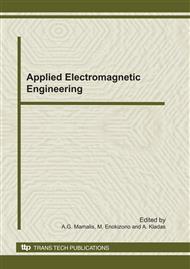p.455
p.466
p.477
p.487
p.497
p.507
p.517
p.526
p.535
Surface Induction Hardening Models Based on a Novel Computational Method of Artificial Change of Material Parameters
Abstract:
The paper deals with a novel method suitable for modelling of surface induction hardening and other tasks, where the problem of discretisation of very thin eddy-currents surface layer is present. The method is based on artificial change of material parameters in the computer model. A methodology is suggested and limitations of its application are thoroughly tested. Odds and merits over other possible methods are also discussed.
Info:
Periodical:
Pages:
517-525
Citation:
Online since:
December 2010
Authors:
Price:
Сopyright:
© 2011 Trans Tech Publications Ltd. All Rights Reserved
Share:
Citation:


